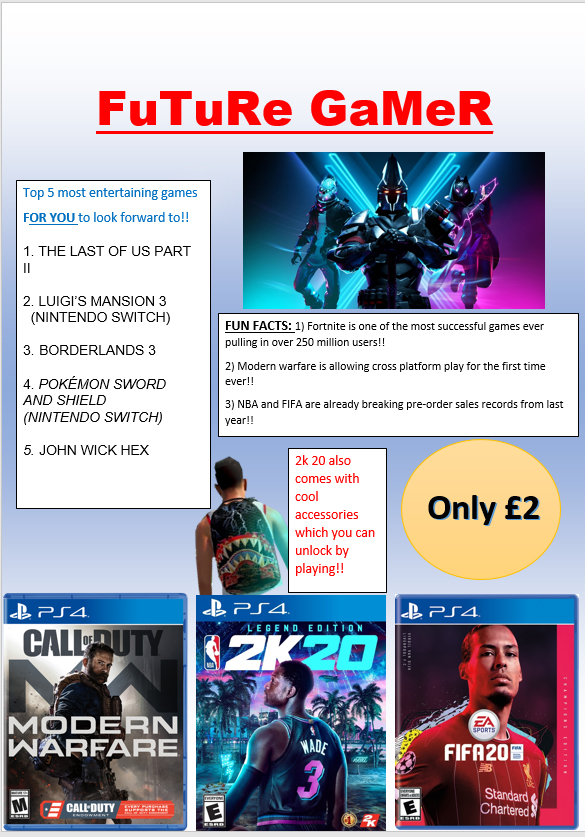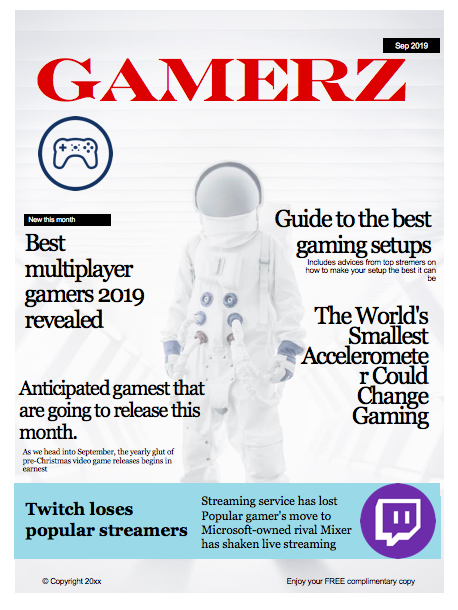- Barthes – (Roland Barthes) is one of the leading theorists of semiotics
- Pierce – founder of semiotic theories
- Saussure – the study of signs
- Semiotics – study signs
- Sign – a gesture
- Signifier – a message
- Signified – meaning/gesture
- Icon – something represented as a symbol
- Index – a sign of something
- Symbol – a sign that associated with something
- Code – a system of words/symbols
- Dominant Signifier – a strong message
- Anchorage –
- Ideology
- Paradigm – pattern
- Syntagm
- Signifcation – exact meaning
- Denotation – meaning of something
- Connotation – a feeling a word gives
- Myth – a false belief or idea
- radical text – challenges the dominant ideology
- reactionary – dominants/supports common sense
Category Archives: Uncategorized
Filters
Summer Task

My intentions with my front cover magazine for gamers was to give my audience an insight on what upcoming games to look forward to playing in the future. The ideas I came up with was to add some of the most promising games to come out later in the year, by doing this I added in a few images of the games that are most likely to be most popular to play I also added in some already released games such as Fortnite which I believe will still be popular. My target audience ranges from ages three to eighteen and older, this is because it relates to the age policies certain games have for example games such as FIFA twenty is aged at the age of three years old and older, whereas games like Modern Warfare are aged at the ages of eighteen and older. I also added in a top five list on my front cover in this list I covered the top ten most entertaining games to look forward to in the future. The reason why I decided to make a front cover magazine on future games instead of games which are already out is because, I myself play games however I have stopped recently as I have become bored of the games that are out at the moment. I am waiting for new games to be released so I can start playing again this is how I came up with the idea of future games. Some of the games that are featured by having their own images are personal favourites of mine that I am looking forward to play and a few other of the games that are mentioned I researched on google and found some top twenty lists and got some games of those lists to put on my front cover, I chose carefully with these games as I didn’t want all the games on my list to be similar I wanted to keep it unique so it has various choice for my audience. Another idea I came up with was to add in some more text about some fun facts of the games that are featured on the magazine front cover, by doing this it could increase the knowledge of the games to my audience and it will also give them more of a reason to purchase one of these games that have been featured. In conclusion, I believe my intentions on portraying a front cover magazine for games to look forward to in the future was a good idea as it is accessible to all ages so that they can be intrigued and willing to read more. I also believe, I balanced the amount of text I used out with the images I used. By doing this it doesn’t make it to boring for the younger audience but it also includes reasonable facts for the older audience this means that the magazine balances out for my target audience not just heavily influenced on one.
- Icon:
- Looks like a footballer
- Looks like a man with a backpack
- Looks like a neon light
- Looks like a man
- Indexical:
- Clothes
- Red color font
- Symbolic:
- Game headlines
- Nba Logo
Media Definitions
- Barthes = he created the 5 narrative codes and is known as the “Father of Media Studies”
- Pierce = he was the discoverer of Semiotics and established that signs can be split into 3 categories: Iconic, Indexual and Symbolic.
- Saussure = he was a was a Swiss linguist and semiotician (person who studies semiotics)
- Semiotics = This is the scientific study of sign and symbols
- Sign =A mark, sign or word that indicates, signifies, or is understood as representing an idea, object, or relationship. For example, a love heart could be a sign of being in love.
- Signifier = This is the thing, item, or code that we ‘read’ on a source of media, this can include images, drawings, text, image captions.
- Signified = This is the idea or meaning being expressed by a signifier. For example, with the Mario photo as the cover image on my magazine, it is signified the edition is all about Mario.
- Icon = This is an image defined by the way in which it is used; any image deemed “icon” is understood as a medium for an outlying entity. For example, gaming consoles are icons of gaming magazines.
- Index = It is also called the ‘efficiency indicator’. Index describes the degree to which a target audience matches to the entire population of an analysed platform.
- Symbol = This is a mark,a meaning or a word.
- Code = These are loads of signs that create a meaning of something. Media codes include the use of camera, acting, setting, mise en scene, editing, lighting, sound, special effects, typography, colour, visual composition, text and graphics to develop a TV advert.
- Dominant Signifier = The most important thing we see on a piece of media. It also provides anchorage (signs with a fixed meaning)
- Anchorage = Anchorage is when a piece of media uses another piece of media to lower the amount off connotations in the first piece of media, therefore allowing the audience to interpret it much more easily. For instance, in a newspaper, pictures are accompanied by a caption that allows us to understand what the picture is showing us
- Ideology = A view shared shared by a wide group of people
- Paradigm = a group of signs
- Syntagm = These are signs but if one sign is removed, nothing will make sense. Thus, for example, the letters in a word have syntagmatic relationship with one another, as do the words in a sentence or the objects in a picture.
- Signifcation =this is what we think something is
- Denotation = this is usually the first level of analysis: what the person can visually see on a source of media (ie magazines and TV adverts)
- Connotation = Connotation is when you expand on your denotation and is a second level of analysis because you identify what the denotation represents.
- Myth = these are false beliefs and stories which aren’t proved true by science. In media terms, Barthes discovered things in the news (ie articles) that aren’t true but people choose to believe is true is also a myth. In today’s terms, this can be known as “fake news”.
- A radical text = A text that challenges myths and the dominant ideology
- A reactionary text = this supports the dominant ideology
Media Signs
An Iconic sign:
- the human (man)
- the gun
- coat
An indexical sign:
- The word “battle field” links to the game relating to a battle field, linking to the sound of a battle.
- The gun links to a gun shot.
- The orange beam of light behind the man, links to the sun, as the color orange replicates a sunset.
- The word “space” links to non-human planet.
A symbolic Sign:
- The word “indie” could arguably link to country India.
- The font color of game is dark (black), which links to coldness and gives off an eerie atmosphere.
- The letters/words
- The heading

Signs in My Cover

Different Signs on My Nintendo Magazine
Iconic Signs:
- Nintendo Logo
- Red font (Nintendo branding)
- Super Mario logo
- Barcode = shows it is a magazine
- Mario image = looks exactly like Mario
- Mario power-ups in the background relate to the Super Mario games.
Indexical Signs:
- Super Mario
- Red font colouring
- Mario coins in the background
- Mario power-ups in the background
- Super Mario colours (rainbow used in the Super Mario logo)
- The font used for the font saying “Super Mario Strikes Again” is similar to the famous Super Mario Logo used in all the games within the Super Mario franchise.
- Price on my magazine cover
- Mario jumping = associated with the game as Mario jumps to collect the coins
- Pop up for Super Smash Brothers in the bottom right hand corner as Mario is a playable character in the Super Smash Brothers Game.
Symbolic Signs:
- Pop up for Super Smash Brothers in the bottom right hand corner as Mario is a playable character in the Super Smash Brothers Game.
- Super Mario colours
- Red font colouring
- Mario coins in the background
- Mario power-ups in the background
- White background (colour of Mario’s gloves)
- The font used for the “June 2019 Edition”
Introduction Questions
What is media?
Media is a way of communication.
What is media studies?
Media studies is the critical/ cultural analysis of all media formats and the role they play in society.
summer task

Iconic
- controller drawing
- astronaut image,
Indexical
- red color font
- astronaut suit
A symbolic sign
- game headlines
- twitch logo


Front Cover:

Media Timeline
Newspapers – They were first circulating in the 17th century, and the first one was printed in 1665.
Advertising- Advertisement`s were first introduced in the 16th and 17th century’s within newspapers.
Magazines – The earliest form of magazine was launched in Germany in 1663. America`s first magazine was launched in 1923.
Radio – The first practical radio transmitters and receivers were developed around 1895-6 by Italian Guglielmo Marconi, and radio began to be used commercially around 1900.
Cinema – The first cinema was in Berlin Wintergarden Theatre. This was in 1895 and a short, silent film was presented by the Skladanowsky brothers.
TV- The first ever television stations started appearing in America in the late 1920s and early 1930`s.
Music Video – The first music video as we would know it today was Tony Bennetts “Stranger in Paradise”, and this was in 1953.
Video Game – thought be have been created in 1958 by William Higinbotham.
Online – in 1993, researchers began to assemble what we would now know as the modern internet.
